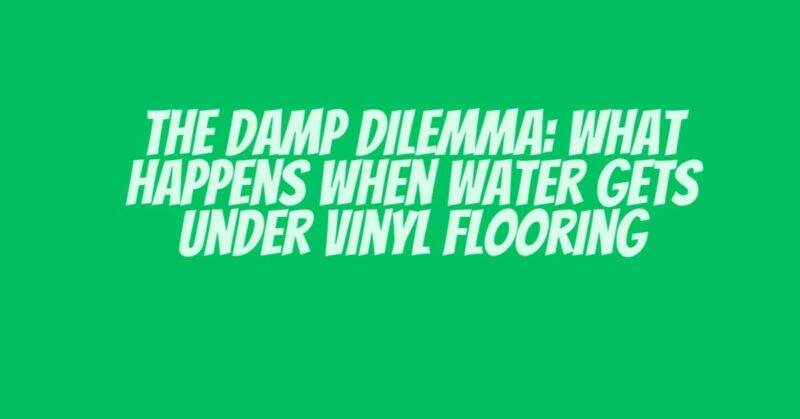Vinyl flooring has become a popular choice for homeowners and commercial spaces due to its durability, ease of maintenance, and versatility in design. However, like any flooring material, vinyl is not impervious to water damage. When water manages to seep beneath vinyl flooring, it can lead to a range of issues that can compromise the integrity and appearance of your floor. In this comprehensive article, we’ll explore what happens when water gets under vinyl flooring, the potential consequences, and steps to address and prevent this problem.
**1. Bubbling and Buckling
One of the most noticeable effects of water beneath vinyl flooring is the formation of bubbles or buckling. When moisture infiltrates the subfloor or the adhesive layer beneath the vinyl, it can cause the material to lift and separate from the subfloor. This results in unsightly bubbles or waves in the flooring, which not only diminish its appearance but also create a tripping hazard.
**2. Mold and Mildew Growth
Water and moisture provide an ideal environment for mold and mildew to thrive. When these microorganisms take hold beneath vinyl flooring, they can not only damage the flooring itself but also pose health risks to occupants. Mold and mildew growth can lead to respiratory issues and exacerbate allergies.
**3. Discoloration and Staining
Water under vinyl flooring can cause discoloration and staining. This is particularly evident if the water contains minerals or if there are impurities in the subfloor. The result is often unsightly and challenging to remove stains that can mar the appearance of your flooring.
**4. Foul Odors
Moisture trapped beneath vinyl flooring can create a musty or unpleasant odor. This odor can permeate the room and be particularly noticeable on humid days.
**5. Compromised Adhesive
Water damage can weaken the adhesive that holds the vinyl flooring in place. As the adhesive deteriorates, the vinyl may begin to separate from the subfloor or show signs of increased wear and tear.
**6. Subfloor Damage
Prolonged exposure to moisture can damage the subfloor underneath the vinyl. Depending on the subfloor material (e.g., plywood or concrete), this can lead to structural issues, including warping, rotting, or disintegration.
Addressing Water Damage Under Vinyl Flooring
If you suspect or discover water beneath your vinyl flooring, it’s crucial to address the issue promptly to minimize damage. Here are the steps to take:
**1. Identify the Source: Determine the source of the water intrusion and address it. It may be a plumbing leak, a damaged seal, or flooding from external sources.
**2. Remove the Flooring: Carefully remove the affected vinyl flooring and inspect the subfloor for damage. If the subfloor is compromised, repairs may be necessary.
**3. Dry and Ventilate: Thoroughly dry the subfloor and the underside of the vinyl flooring. Ensure proper ventilation to prevent mold and mildew growth.
**4. Replace Damaged Materials: If the vinyl or subfloor is severely damaged, you may need to replace them. If it’s a small area, a patch or replacement of the damaged section may suffice.
**5. Prevent Future Damage: Take steps to prevent water damage in the future. This may include addressing plumbing issues, improving waterproofing, or using moisture barriers during installation.
Conclusion
Water getting under vinyl flooring is a problem that should not be ignored. It can lead to visible damage, mold growth, and structural issues if left untreated. Prompt identification and remediation of water damage are essential to preserving the beauty and longevity of your vinyl flooring. Additionally, taking preventive measures to protect your flooring from water infiltration can save you time, money, and headaches in the long run.


